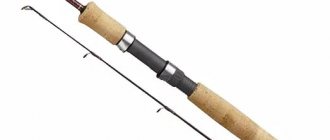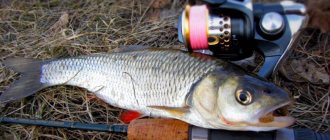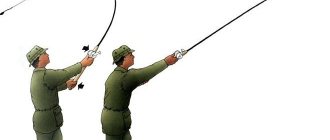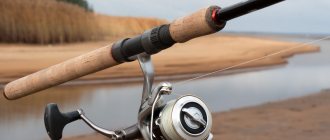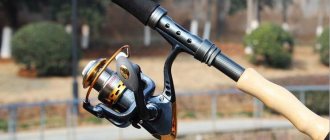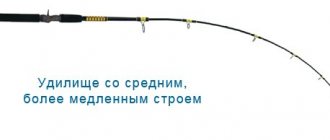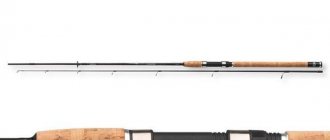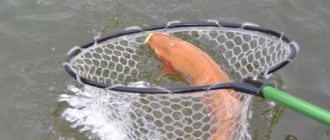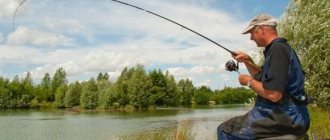The fishing tackle market is overflowing with an assortment of spinning rods, from little-known brands at budget prices to expensive branded products. They are classified by length, type of action, test, material and other parameters. But how can a person who is just starting to learn fishing make the right choice and not get confused among many incomprehensible numbers and indicators?
This article will step by step help beginners understand how to choose a spinning rod, what types they are divided into, and what to look for. It will indicate the key points when purchasing and quantities that are not so important for fishing.
Based on what characteristics is the choice made?
In order to quickly master the technique of casting and retrieving, experienced professionals always advise beginners to start with universal rods. Their advantage is that the tackle is suitable for fishing from the shore and boats. It is possible to use a wide range of baits of different weights. An example of the indicators of such a spinning rod: length 2.4 m, test for baits from 5 to 25 g.
But such versatility hides disadvantages:
- Reduced comfort of fishing from a boat. The optimal length is considered to be from 1.8 to 2.1 m.
- Light lures will not reach the target distance. They are practically not felt when wiring.
- The use of heavy jig heads and other baits weighing more than 20 g is unacceptable, as the risk of putting an increased load on the rod increases. Over time, it can cause gear failure.
As a training rod for practicing casting techniques, casting distance accuracy, or simply as a spare tackle, this is a good option. But it’s better not to waste money and buy several rods with working properties for different fishing conditions and types of predatory fish.
In addition, there are other points to consider before purchasing:
- body of water with or without current;
- bait immersion depth;
- shore fishing or from a boat;
- estimated size, type of fish;
- types of baits used.
Below we will analyze the features of the main indicators.
How long should it be
Spinning rods are produced with a length of 1.8 to 4 m. But the specific choice is determined by the nuances of fishing:
- For coastal fishing on rivers and reservoirs up to 120 m wide, an excellent option with a length of 2.1 to 2.7 m.
- Tackle over 2.7 m long is useful for fishing on large deep-water rivers, reservoirs, lakes, where the casting range reaches 100 m or more.
- For a boat, 1.9 m is best.
Having decided on the length, you need to move on to analyzing other indicators.
Bait test
The working property of a spinning rod, by which the fisherman determines the upper and lower weight limits of the baits used. The lower limit of the test indicates the minimum permissible weight of a wobbler, spoon or jig head. In the case when the specified indicator and the mass of the bait are equal, then when performing the retrieve, the fisherman will feel the fullness of its unique game. If the weight of the bait is less than the lower test, then even an experienced master will not feel the bait during retrieving.
The upper limit of the test indicates the maximum permissible weight of the bait. When a fisherman decides to ignore this value and take, say, a spoon of greater mass, then during casting this can cause a breakdown. It is important to remember that not all manufacturers conscientiously indicate the test gear up to 1 g, in particular, the lower limit.
The test is divided into:
- ultra-light – from 1 to 5 g;
- light – from 5 to 15 g;
- medium - from 7 to 25 g;
- heavy – over 20 g.
For example, an ultralight rod with a test weight of 1 to 5 g allows you to use light baits for small and medium-sized fish (perch, ruff). But with a competent and unhurried approach to fishing, and an adjusted reel clutch, experienced fishermen manage to catch large pike or pike perch using ultralight.
For fishing on small rivers from shallow depths, a rod with light or medium test is sufficient. For deep-sea reservoirs, you need to take gear with a dough of 20 g and above. When trolling, only large baits are used, so the spinning rod is taken with a heavy test so that it can easily withstand and feel the play of bait weighing over 60 g. There are gear options where, instead of a test, manufacturers indicate a range of breaking loads.
Material of manufacture
There are several types:
- Composite The raw material is obtained by combining fiberglass and carbon fiber. The rod comes with average stiffness. This is a budget fishing option. But it’s much safer to search on the Internet or in stores for an inexpensive carbon fiber spinning rod - it will last many times longer.
- Fiberglass. Durable material, but heavy. Does not require maintenance. It's cheap. Perfect for trolling fishing when there is no need to make frequent casts.
- Carbon fiber (carbon fiber), carbon, graphite. The lightest and at the same time durable material. According to the modulus of graphite content, they are divided into M1, M2, etc. The lower this indicator, the higher the flexibility of the rod and the duration of vibration of its tip. But at the same time, this reduces the casting range and worsens the reaction speed of the spinning rod. The presence of a large amount of carbon fiber increases the rigidity of the gear and at the same time its fragility.
There is an opinion among fishermen that the high content of carbon fiber in a fishing rod makes it very fragile when used in winter conditions and increases the risk of breakage. Therefore, for fishing during the first severe frosts, it is better to take gear with a medium content of carbon fiber modulus.
What is a system and how to choose it
The structure is called the Young's modulus of elasticity coefficient. This indicator shows the time it takes to return to the starting position after casting the rod. The sensitivity of the gear depends on the system. When fishing with a hard spinning rod, the fisherman feels all the vibrations. But as this parameter increases, the casting range decreases
The classification of rod action is as follows:
- Extra Fast – very fast. Flexibility up to ¼ of the tackle length. Not designed for long casts. Does not soften the jerks of fish when playing.
- Fast - fast. Flexibility up to ½ length. Fishermen call it a “half” formation.
- Moderate - average. Flexibility up to ¾ of the length of the tackle.
- Slow - slow. The form bends along its entire length. Another name is “parabolic” system. Of all types, it is characterized by the longest cast. It softens the jerks of the fish well when playing, thereby reducing the load on the fishing line.
Among fishermen, fast and medium action are considered popular.
How to choose a fly rod for fishing from a boat
The situation becomes more complicated during the height of the summer heat, when there is less water in the reservoir and it moves away from the shore. In this case, using a fly rod can make fishing more effective.
- In most cases, a blank from 3 to 5 m is taken. In this case, it is possible to make a successful cast without swimming too far from the shore. This increases the angler's maneuverability.
- The tuning is usually medium or medium-fast. For larger fish, using a slow action will be more effective. This will help guide the fish without sudden jerks. Also in this case it is convenient to make a smooth hook.
- A test for catching fish weighing one kilogram can be taken in the range from 10 to 30 grams. It depends on the weight of the fish.
- The number of elbows must correspond to the size of the fishing rod used.
We must take into account:
- How important are casting range and accuracy for this type of fishing? The first parameter depends on the size of the form. In the second case, accuracy is determined by how well the test for a given fishing rod matches the weight of the bait used.
- The comfort of the fishing process itself is of great importance. There is not much space on the boat, and the boat is also unstable.
- It is important that the type of fishing rod is optimal for catching the desired fish. If we are talking about large specimens, a long fishing rod will provide more opportunities to hold the predator.
- When fishing from a boat, it is better if the spinning rod is equipped in advance. At the same time, its type, shape and size must be such that it is comfortable to move with them across the surface of the water in order to search for the most catchable place in a given reservoir.
Showed themselves well:
- Fiberglass forms. Heavy and soft, durable, do not require special storage conditions.
- Made from carbon fiber. Tough, light and durable. At the same time, they will be much more expensive than other options and they need to be stored taking into account special requirements.
- Made from composite. Their specific features depend on the exact composition of the material used.
Plug or telescopic design
Depending on the design features, 2 types of fishing rods go on sale:
- Plug-in. Massive long spinning rods. They don't fold. Often made from fragile raw materials. Any even minor damage can cause breakage or breakage of the gear, which means ruined fishing. Require special attention during transportation. Therefore, it is recommended to pack them in special tubes. Available in a wide range of lengths.
- Telescopic. What are they also called folding ones? Convenient to store and transport. They won't take up much space in a fisherman's arsenal. The choice of these rods in length is small. Due to the large number of connections, backlashes may form. For this reason, many fishermen prefer plug-in spinning rods.
It is impossible to say unequivocally that one of the types is many times better than the other. Therefore, here the fisherman chooses at his own discretion, based on the experience of past fishing trips. But professional forms are available in the form of plugs.
Is there a universal spinning rod?
What if you need a universal spinning rod of medium power
(5-25g.), for example, for fishing with popular techniques: jig and twitching.
Is it possible to choose a universal option here? In this case, spinning can be called universal only under certain conditions
:
Condition 1.
If baits of approximately the same weight (10-18g) are used.
Condition 2.
If the universal rod length is used, which is about 7.6 feet or 2.29 meters.
Condition 3.
The spinning rod must be of high quality. Made from high modulus carbon fiber and assembled in Japan. Such spinning rods have a complex structure that can suit different conditions. The spinning material will provide a high level of sensitivity and control over the bait (in jigging and twitching).
Only under specific conditions:
Short twitching spinning rods (up to 2.1 m) or long jigging rods (2.7-3 m) will work perfectly only for the purposes for which it is made. They will be less suitable for some other tasks, and not suitable for others at all. They cannot be called universal in any way.
We've sorted out the nuances of versatility. Now let's talk about choosing a spinning rod.
- for medium-sized fish, blanks 2.1 m in length are best suited;
- for large specimens weighing more than 3 kg, you can take gear within 2.7-3.1 m;
- when fishing in cramped conditions or from a boat, a length of 1.6-1.8 m is sufficient to catch small fish weighing up to 2 kg.
A few recommendations for beginners
It is worth considering the following points:
- For catching small, medium-sized fish on a small river up to 30 m wide, gear with a length of 2 to 2.4 m is optimal, with a very fast, fast action. Working test – from 1–5 to 4–16 g. Lures – lightweight spoons, small wobblers, jig heads.
- When catching medium, large fish from the shore on a large river with a channel width of over 100 m, you need to take a rod with a length of 2.5 to 3 m, fast or very fast action. Test – from 7 to 30 g. Lures – jig heads with edible silicone, spoons, wobblers up to 30 g.
- For fishing from a boat on a still body of water without a current, the recommended length is from 1.8 to 2.3 m. Action – fast, very fast, medium (depending on the type and weight of the bait). Test - up to 20 g. Fishing from a boat in deep-sea reservoirs should be done with a spinning rod with a length of 2.1 to 2.5 m. The action is very fast. Test - up to 35 g. Lures - wobblers, jig heads.
Advantages of spinning fishing from a boat
Fishing from a boat has its undeniable advantages:
- If you go fishing with a spinning rod from a boat, there are good opportunities for long casting.
- Fishing with a short spinning rod from a vessel does not reduce the opportunity to swim to a promising fishing spot.
- Water transport gives freedom of movement. Here, the optimal length of the spinning rod used is determined not by the remoteness of the place, but by the convenience and reliability of holding the gear. What is more important is the correct length of the spinning rod.
- You can use a boat fishing echo sounder to more reliably identify fishing spots.
Rating of spinning rods (top 10)
When forming the list, the following were taken into account:
- price;
- brand awareness;
- versatility;
- reliability of the material;
- average service life.
- reviews and ratings from anglers
As a result, this is the list:
- Major Craft Dodger 672M.
- Aiko Ranger 200ML.
- SLrods Atria 672UL.
- Zetrix Azura 792HH.
- Black Hole Hurricane MS-672ML.
- Kosadaka Jet 210ML.
- SLrods Atria 692L.
- Maximus Sea Wolf 21ML.
- Zemex Bass Addiction S-662M.
- Ryobi Zauber 180.
You can only purchase such fishing rods from official distributors, company stores or websites. In other cases, there is a high risk of counterfeiting.
What to look for when purchasing
Before purchasing, consider the following factors:
- Visual inspection. There should be no surface defects.
- The spinning rod must be perfectly straight along its entire length.
- The rings fit tightly, without traces of glue. The internal parts are smooth. Any rotation is excluded.
- The axis and rings for the spool holder converge into one line.
- The spool nut rotates freely.
If possible, attach the reel without leaving the store to understand the quality of the device. Be wary of promotional offers with deep discounts. There have been cases when a retail chain needs to sell goods with minor defects, so the price was significantly reduced.
Conclusion and final tips
In summing up, I would like to draw the attention of beginners to the following points:
- For starters, a carbon-based composite fishing rod will suffice.
- For fishing from the shore in conditions of increased vegetation, you need to take a spinning rod with a length of 1.8–2.1 m. For long casts on reservoirs, take a longer length of 2.4 m.
- The test is selected by the fisherman based on the size of the bait and the size of the desired trophy. The range from 5 to 25 g is considered universal.
- The casting distance of the rod depends on the choice of action. The most popular ones are medium and fast.
Before purchasing, we recommend that you familiarize yourself with our top 10 best models. Talk to experienced fishermen in your area to better understand the challenges and risks you will encounter on local waters.
Lures
When fishing from a boat, the use of jig baits worked well. Large and bright, they showed good effectiveness during short casts.
You can also use foam fish. Their size changes over the seasons. In spring, small baits are more catchy. Typically, up to two dozen specimens can be used in one fishing trip.
When using twisters, it is important to choose the right color. This usually requires trying different options and evaluating the results.
